Detecting and Assessing Nondominant Farmland Area with Long-Term MODIS Time Series Images
Abstract
1. Introduction
2. Material and Methods
2.1. Study Area
2.2. Data Acquisition
2.3. Determination of the Critical Period for the Remote Sensing Images
2.4. Phenology Zoning of Farmland
2.5. NAF Extraction Modeling
2.6. Vector Angle Method
2.7. Correlation Analysis
2.8. Accuracy Assessment
3. Results
3.1. Model Validation
3.2. NAF Patterns
3.3. NAF Classification
3.4. NAF Pattern Formed Factors
4. Discussion
5. Conclusions
Author Contributions
Funding
Acknowledgments
Conflicts of Interest
Appendix A
Appendix A.1. Determination of the Critical Period for the Remote Sensing Images
| County | Crop | Disaster Type | Time | Area (104 mu) | Percentage (%) |
|---|---|---|---|---|---|
| Heihe | Wheat | Drought | 6 June 2000 | Over 100 | |
| Soybean | Drought | 10 July 2000 | 70 | 90–100 | |
| Wheat | Drought | 7 June 2001 | 1 | 80–89 | |
| Other crops | Hail | 16 July 2001 | 0.8 | 10–19 | |
| Wheat | Wind disaster | 12 July 2002 | 0.3 | 0–9 | |
| Soybean | Chilling injury | 8 June 2003 | 5.1 | 0–9 | |
| All crops | Drought | 12 June 2003 | 5.0 | 0–9 | |
| Soybean | Frost | 7 June 2004 | 3.1 | 0–9 | |
| Wheat | Drought | 21 June 2008 | 7.5 | 70–79 | |
| Wheat | Drought | 1 June 2010 | 1.0 | 40–49 | |
| Keshan | Other crops | Drought | 11 June 2000 | Over 100 | 80–89 |
| Other crops | Drought | 3 June 2001 | Over 100 | 70–79 | |
| Other crops | Pest | 2 June 2002 | Over 100 | 80–89 | |
| All crops | Rainstorm | 28 June 2003 | 37.5 | 10–19 | |
| Rainstorm | 28 July 2003 | Over 100 | 90–100 | ||
| All crops | Drought | 22 June 2010 | Over 100 | 90–100 | |
| Longjiang | All crops | Drought | 3 June 2003 | Over 100 | 60–69 |
| All crops | Drought | 11 June 2004 | Over 100 | 90–100 | |
| All crops | Drought | 21 July 2007 | Over 100 | 70–79 | |
| All crops | Drought | 24 May 2009 | Over 100 | 80–89 | |
| Harbin | Other crops | Drought | 7 June 2000 | 28.6 | 50–59 |
| Other crops | Hail | 4 July 2001 | 3.1 | 0–9 | |
| All crops | Drought | 21 May 2003 | 45.0 | 50–59 | |
| All crops | Drought | 21 May 2006 | 51.0 | 20–29 | |
| Fujin | Wheat | Drought | 14 June 2000 | 35.0 | 70–79 |
| Wheat | Drought | 1 July 2000 | 4.0 | 80–89 | |
| Fuyuan | Soybean | Drought | 1 July 2000 | 60.0 | 60–69 |
| Boli | Other crops | Drought | 20 June 2000 | 76.6 | 70–79 |
| Other crops | Flood | 17 July 2002 | 20.0 | 20–29 | |
| All crops | Drought | 28 May 2003 | 30.0 | 30–39 | |
| Soybean | Pest | 21 August 2004 | 10.0 | 10–19 | |
| All crops | Drought | 13 July 2007 | 15.2 | 0–9 | |
| Fangzheng | Rice | Drought | 1 June 2000 | 16.2 | 20–29 |
| Other crops | Hail | 2, 7 and 10 July 2002 | 1.1 | 0–9 | |
| All crops | Hail | 17 July 2003 | 1.8 | 0–9 | |
| Corn | Hail | 9 September 2004 | 45.0 | 0–9 | |
| Ningan | Other crops | Drought | 18 June 2000 | 0.8 | 50–59 |
| Hailun | Other crops | Drought | 11 June 2001 | Over 100 | 90–100 |
| Other crops | Other disasters | 21, 22 and 26 June 2001 | Over 100 | 40–49 | |
| Other crops | Other disasters | 1, 2 and 6 July 2001 | Over 100 | 30–39 | |
| All crops | Rainstorm | 28 August 2003 | Over 100 | 70–79 |
Appendix A.2. Crop Sample Points
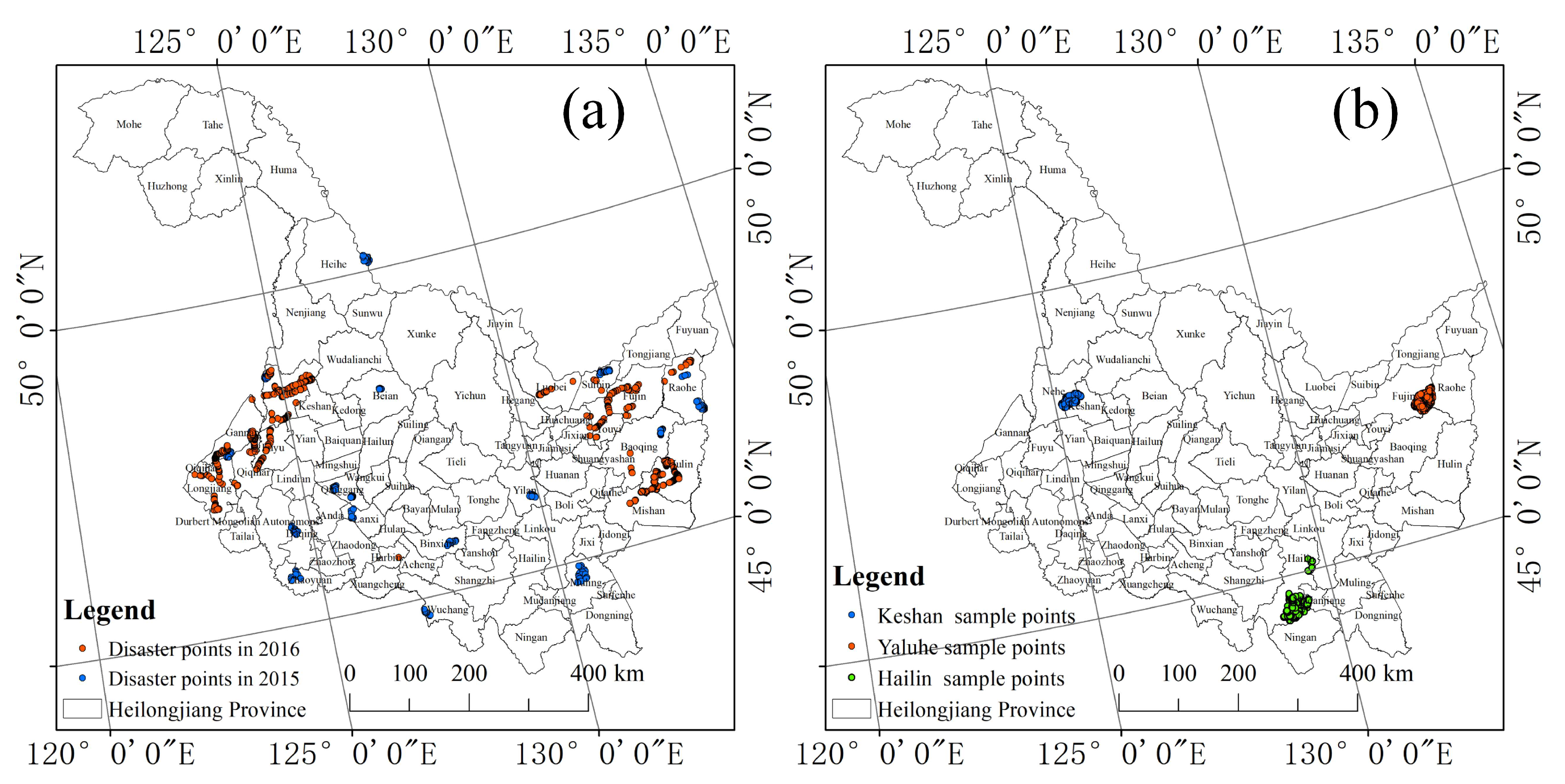
Appendix A.3. NDVI Histogram

Appendix A.4. NAF Range
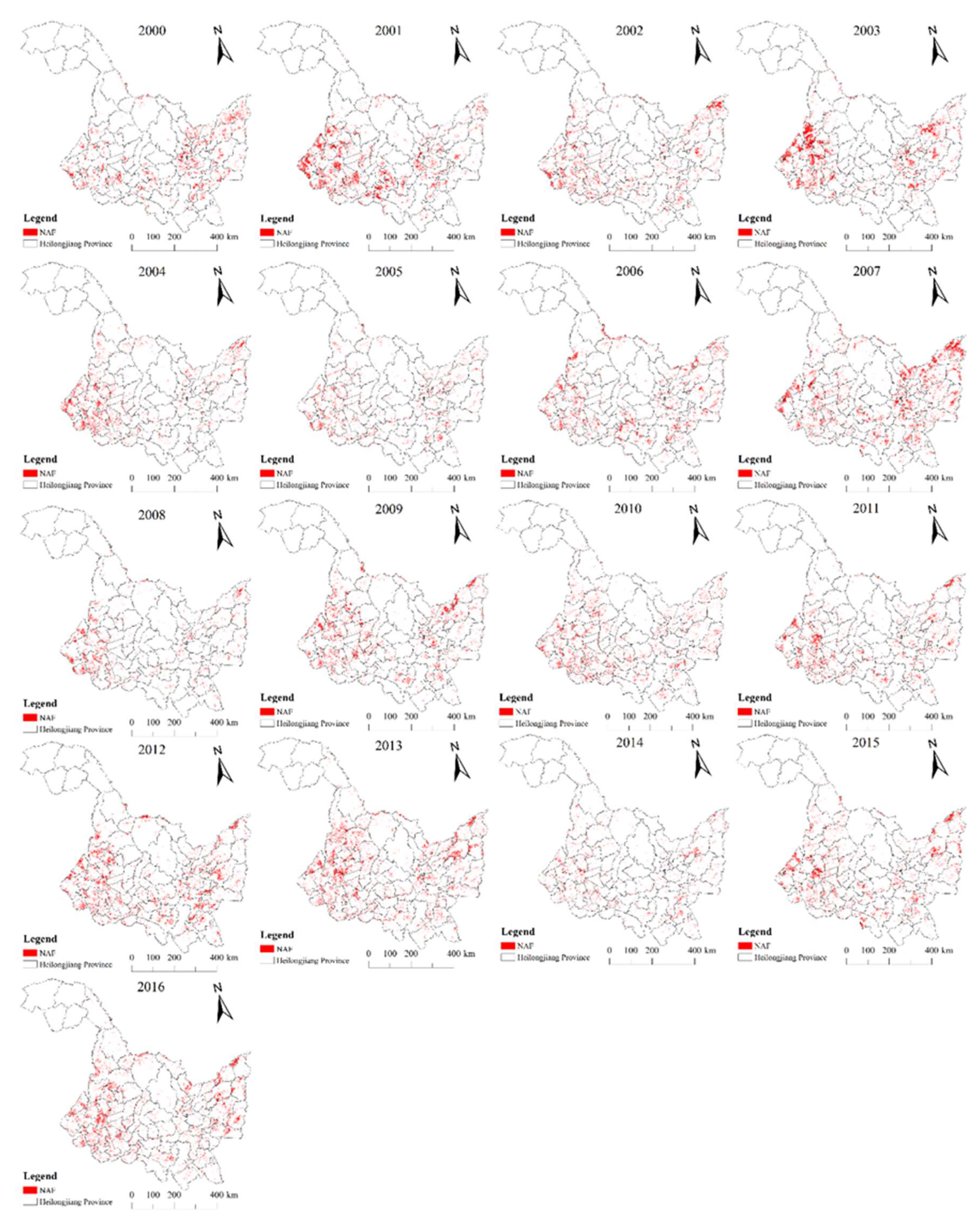
Appendix A.5. The Elevation Map in Study Area
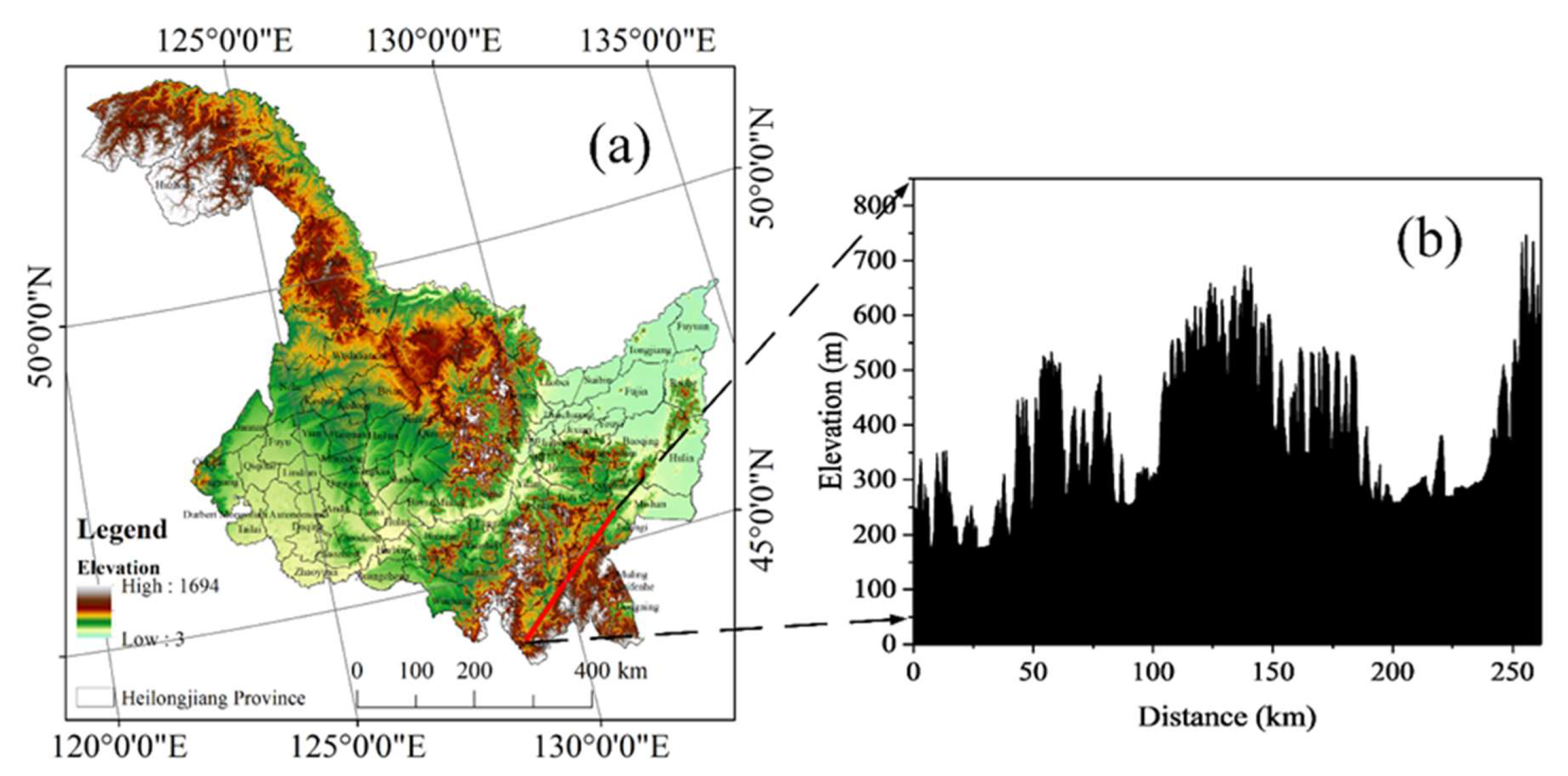
Appendix A.6. Spatial Precipitation Map
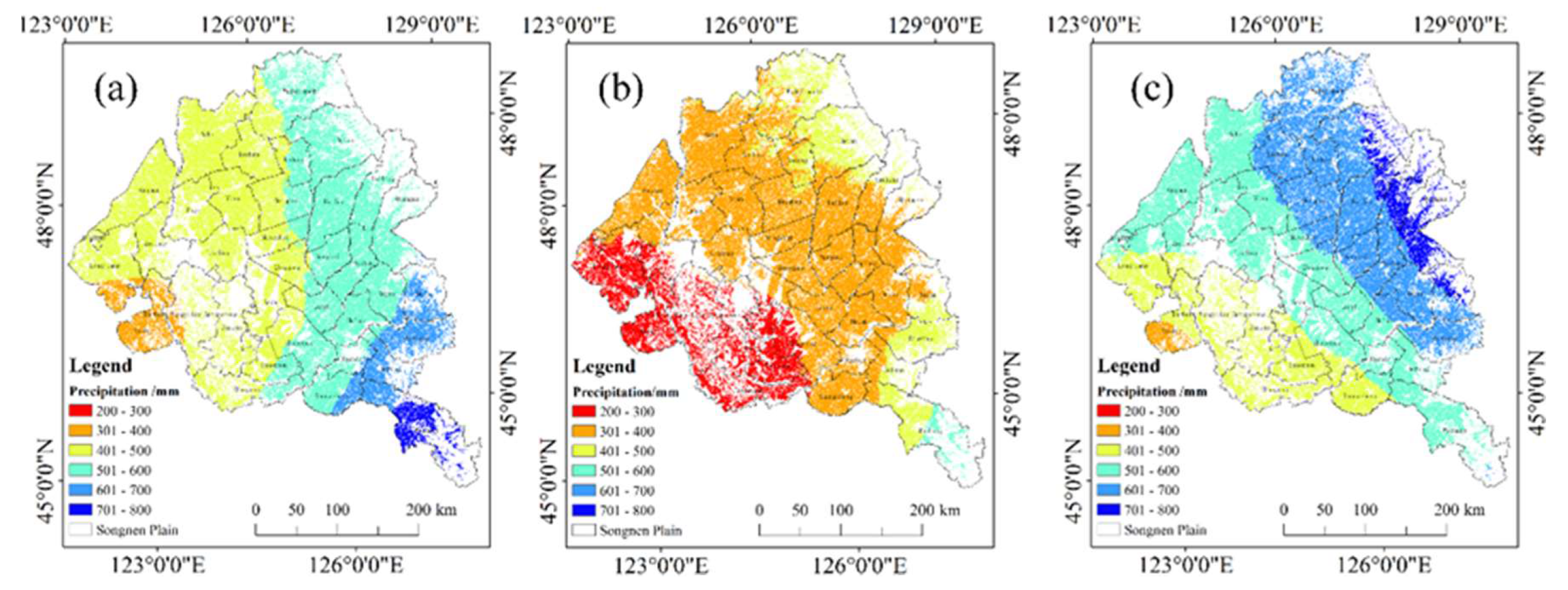

Appendix A.7. NAF Interannual Variation Curve
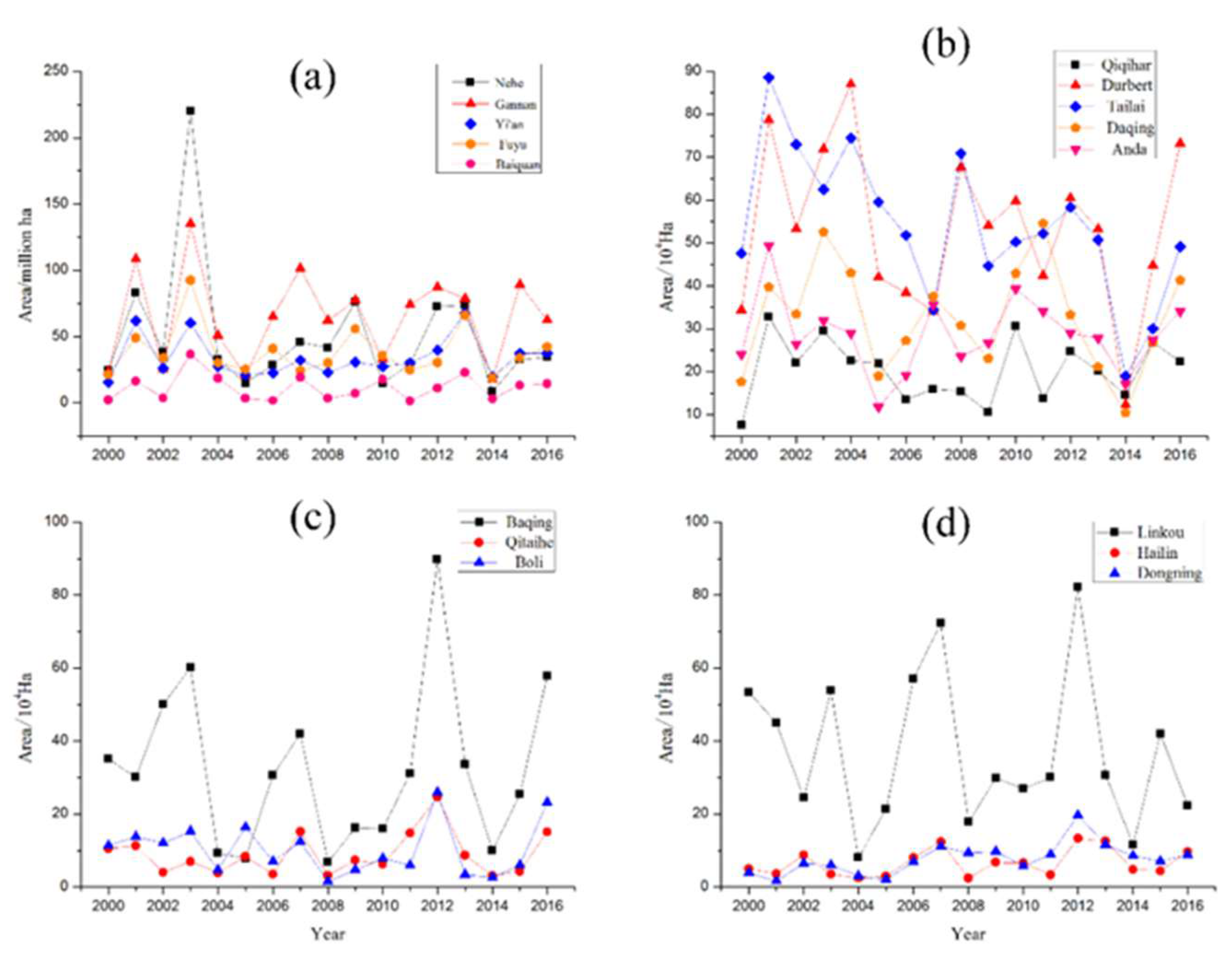
References
- Adetunjia, O.; Chigozirim, A.; Otunemec, N.; Omotoshod, O.J. Dawning of Progressive Web Applications (PWA): Edging Out the Pitfalls of Traditional Mobile Development. Am. Sci. Res. J. Eng. Technol. Sci. (ASRJETS) 2020, 68, 85–99. [Google Scholar]
- Yan, H.; Ji, Y.; Liu, J.; Liu, F.; Hu, Y.; Kuang, W. Potential promoted productivity and spatial patterns of medium- and low-yield cropland land in China. J. Geogr. Sci. 2016, 26, 259–271. [Google Scholar] [CrossRef]
- Xu, E.; Zhang, H. Spatially-explicit sensitivity analysis for land suitability evaluation. Appl. Geogr. 2013, 45, 1–9. [Google Scholar] [CrossRef]
- Zhao, X.; Ye, Y.; Zhou, J.; Liu, L.; Dai, W.; Wang, Q.; Hu, Y. Comprehensive evaluation of cultivated land quality and sensitivity analysis of index weight in hilly region of pearl river delta. Trans. Chin. Soc. Agric. Eng. 2017, 33, 226–235. [Google Scholar] [CrossRef]
- Lesk, C.; Rowhani, P.; Ramankutty, N. Influence of extreme weather disasters on global crop production. Nature 2016, 529, 84–87. [Google Scholar] [CrossRef]
- Wanda, D.K.; Stef, L.; Michael, H.; Laurent, T.; Pol, C.; Ben, S. Assessment of Regional Vegetation Response to Climate Anomalies: A Case Study for Australia Using GIMMS NDVI Time Series between 1982 and 2006. Remote Sens. 2017, 9, 34. [Google Scholar] [CrossRef]
- Zhou, R.; Wu, Y.; Hai, C.; Li, X.; Zhou, D. Comprehensive Evaluation of Cultivated Land Quality Based on GIS in Tumote Right Banner of Inner Mongolia Autonomous Region; Geo-Informatics in Resource Management and Sustainable Ecosystem; Springer: Berlin Heidelberg, Germany, 2013; Volume 399. [Google Scholar]
- Hu, B.; Yan, Z.; Liao, C. GIS-based risk evaluation of karst land degradation disaster: A case of Du’an Yao Autonomous County. J. Nat. Disasters 2006, 15, 100–106. [Google Scholar] [CrossRef]
- Žížala, D.; Zádorová, T.; Jiri, K. Assessment of Soil Degradation by Erosion Based on Analysis of Soil Properties Using Aerial Hyperspectral Images and Ancillary Data, Czech Republic. Remote Sens. 2017, 9, 28. [Google Scholar] [CrossRef]
- Cheng, Y.; Huang, J.; Han, Z.; Guo, J.; Zhao, Y.; Wang, X.; Guo, R. Cold Damage Risk Assessment of Double Cropping Rice in Hunan, China. J. Integr. Agric. 2013, 12, 352–363. [Google Scholar] [CrossRef]
- Liu, Y.; Liu, B.; Yang, X.; Bai, W.; Wang, J. Relationships between drought disasters and crop production during ENSO episodes across the North China Plain. Reg. Environ. Chang. 2015, 15, 1689–1701. [Google Scholar] [CrossRef]
- Yang, Z.; Yu, T.; Hou, Q.; Xia, X.; Feng, H.; Huang, C.; Wang, L.; Lv, Y.; Zhang, M. Geochemical evaluation of land quality in China and its applications. J. Geochem. Explor. 2014, 139, 122–135. [Google Scholar] [CrossRef]
- Rayegani, B.; Barati, S.; Sohrabi, T.A.; Sonboli, B. Remotely sensed data capacities to assess soil degradation. Egypt. J. Remote Sens. Space Sci. 2016, 19, 207–222. [Google Scholar] [CrossRef]
- Nezomba, H.; Mtambanengwe, F.; Tittonell, P.; Mapfumo, P. Practical assessment of soil degradation on smallholder farmers’ fields in Zimbabwe: Integrating local knowledge and scientific diagnostic indicators. Catena 2017, 156, 216–227. [Google Scholar] [CrossRef]
- Reidsma, P.; Ewert, F.; Lansink, A.O.; Leemans, R. Adaptation to climate change and climate variability in European agriculture: The importance of farm level responses. Eur. J. Agron. 2010, 32, 91–102. [Google Scholar] [CrossRef]
- Hou, X.; Han, Y. Herdsmen’s perceptions and adaptation of climate change in typical areas of Inner Mongolia. Geogr. Res. 2011, 30, 1753–1764. [Google Scholar] [CrossRef]
- Zhang, J.; Wang, J.; Li, R.; Chen, S. Agricultural Drought Adaptation Model of Farming-Pastoral Zone and Regional Sustainable Development——A Case Study of Xinghe County in Inner Mongolia. J. Catastrophology 2011, 26, 91–95+113. [Google Scholar]
- Jena, P.P.; Chatterjee, C.; Pradhan, G.; Mishra, A. Are recent frequent high floods in Mahanadi basin in eastern India due to increase in extreme rainfalls. J. Hydrol. 2014, 517, 847–862. [Google Scholar] [CrossRef]
- Vrieling, A.; Sterk, G.; Vigiak, O. Spatial evaluation of soil erosion risk in the West Usambara Mountains, Tanzania. Land Degrad. Dev. 2006, 17, 301–319. [Google Scholar] [CrossRef]
- Chang, C.; Zhao, G.; Li, J.; Wang, L.; Wang, Z. Remote sensing inversion of soil degradation in typical vulnerable ecological region of Yellow River Delta. Trans. Chin. Soc. Agric. Eng. 2015, 31, 127–132. [Google Scholar] [CrossRef]
- Lipiec, J.; Hatano, R. Quantification of compaction effects on soil physical properties and crop growth. Geoderma 2003, 116, 107–136. [Google Scholar] [CrossRef]
- Rahman, M.R.; Lateh, H. Meteorological drought in Bangladesh: Assessing, analysing and hazard mapping using SPI, GIS and monthly rainfall data. Environ. Earth Sci. 2016, 75, 1026. [Google Scholar] [CrossRef]
- Sung, J.H.; Chung, E.; Kim, Y.; Lee, B. Meteorological hazard assessment based on trends and abrupt changes in rainfall characteristics on the Korean peninsula. Theor. Appl. Climatol. 2015, 127, 1–22. [Google Scholar] [CrossRef]
- Kross, A.; McNairn, H.; Lapen, D.; Sunohara, M.; Champagne, C. Assessment of RapidEye vegetation indices for estimation of leaf area index and biomass in corn and soybean crops. Int. J. Appl. Earth Obs. Geoinf. 2015, 34, 235–248. [Google Scholar] [CrossRef]
- Yang, J.; Mao, X.; Wang, K.; Yang, W. The coupled impact of plastic film mulching and deficit irrigation on soil water/heat transfer and water use efficiency of spring wheat in Northwest China. Agric. Water Manag. 2018, 201, 232–245. [Google Scholar] [CrossRef]
- Sharpe, S.M.; Yu, J.; Boyd, N.S. Strawberry, black medic (Medicago lupulina), and Carolina geranium (Geranium carolinianum) growth under light-limiting conditions. Weed Technol. 2019, 33, 503–508. [Google Scholar] [CrossRef]
- Zhang, X.; Liu, H.; Zhang, X.; Yu, S.; Dou, X.; Xie, Y.; Wang, N. Allocate soil individuals to soil classes with topsoil spectral characteristics and decision trees. Geoderma 2018, 320, 12–22. [Google Scholar] [CrossRef]
- Meng, J.; Du, X.; Zhang, M.; You, X.; Wu, B. Integrating Crop Phenophase Information in Large-area Crop Condition Evaluation with Remote Sensing. Remote Sens. Technol. Appl. 2014, 29, 278–285. [Google Scholar]
- Richardson, A.D.; Bailey, A.S.; Denny, E.G.; Martin, C.W.; O’Keefe, J. Phenology of a northern hardwood forest canopy. Glob. Chang. Biol. 2006, 12, 1174–1188. [Google Scholar] [CrossRef]
- Vitasse, Y.; Francois, C.; Delpierre, N.; Dufrene, E.; Kremer, A.; Chuine, I.; Delzon, S. Assessing the effects of climate change on the phenology of European temperate trees. Agric. For. Meteorol. 2011, 151, 969–980. [Google Scholar] [CrossRef]
- Richardson, A.D.; Anderson, R.S.; Arain, M.A.; Barr, A.G.; Bohrer, G.; Chen, G.S.; Chen, J.; Ciais, P.; Davis, K.J.; Desai, A.R.; et al. Terrestrial biosphere models need better representation of vegetation phenology: Results from the North American Carbon Program Site Synthesis. Glob. Chang. Biol. 2012, 18, 566–584. [Google Scholar] [CrossRef]
- Gao, F.; Anderson, M.; Zhang, X.; Yang, Z.; Alfieri, J.; Kustas, W.; Mueller, R.; Johnson, D.; Prueger, J. Toward mapping crop progress at field scales through fusion of Landsat and MODIS imagery. Remote Sens. Environ. 2017, 188, 9–25. [Google Scholar] [CrossRef]
- Liu, H.; Yan, Y.; Zhang, X.; Qiu, Z.; Wang, N.; Yu, W. Remote sensing extraction of crop planting structure oriented to agricultural regionalization. Chin. J. Agric. Resour. Reg. Plan. 2017, 38, 43–54. [Google Scholar]
- Guindin-Garcia, N.; Gitelson, A.A.; Arkebauer, T.J.; Shanahan, J.; Weiss, A. An evaluation of MODIS 8-and 16-day composite products for monitoring maize green leaf area index. Agric. For. Meteorol. 2012, 161, 15–25. [Google Scholar] [CrossRef]
- Huang, Q.; Zhou, Q.; Wang, L.; Li, D. Relationship between Winter Wheat Growth Grades Obtained from Remote-sensing and Meteorological Factor. Trans. Chin. Soc. Agric. Mach. 2014, 45, 301–307. [Google Scholar] [CrossRef]
- Zhang, Y.; Qi, W.; Zhou, C.; Ding, M.; Liu, L.; Gao, J.; Bai, W.; Wang, Z.; Zheng, D. Spatial and temporal variability in the net primary production of alpine grassland on the Tibetan Plateau since 1982. J. Geogr. Sci. 2014, 24, 269–287. [Google Scholar] [CrossRef]
- Wardlow, B.D.; Egbert, S.L.; Kastens, J.H. Analysis of time-series MODIS 250 m vegetation index data for crop classification in the U.S. Central Great Plains. Remote Sens. Environ. 2006, 108, 290–310. [Google Scholar] [CrossRef]
- Cheng, T.; Yang, Z.; Inoue, Y.; Zhu, Y.; Cao, W. Preface: Recent Advances in Remote Sensing for Crop Growth Monitoring. Remote Sens. 2016, 8, 116. [Google Scholar] [CrossRef]
- Muñoz, J.D.; Steibel, J.P.; Snapp, S.; Kravchenko, A.N. Cover crop effect on corn growth and yield as influenced by topography. Agric. Ecosyst. Environ. 2014, 189, 229–239. [Google Scholar] [CrossRef]
- Zhao, H.; Zhou, R.; Drake, S. Effects of aeolian deposition on soil properties and crop growth in sandy soils of northern China. Geoderma 2007, 142, 342–348. [Google Scholar] [CrossRef]
- Zhao, Y.; Xiao, D.; Bai, H.; Tao, F. Research progress on the response and adaptation of crop phenology to climate change in China. Prog. Geogr. 2019, 38, 224–235. [Google Scholar]
- Chen, Y.; Zhang, P.; Liu, S.; Tan, J. The Spatio-temporal Pattern Change and Optimum Layout of Grain Production in the West of Northeast China. Sci. Geogr. Sin. 2016, 36, 1397–1407. [Google Scholar] [CrossRef]
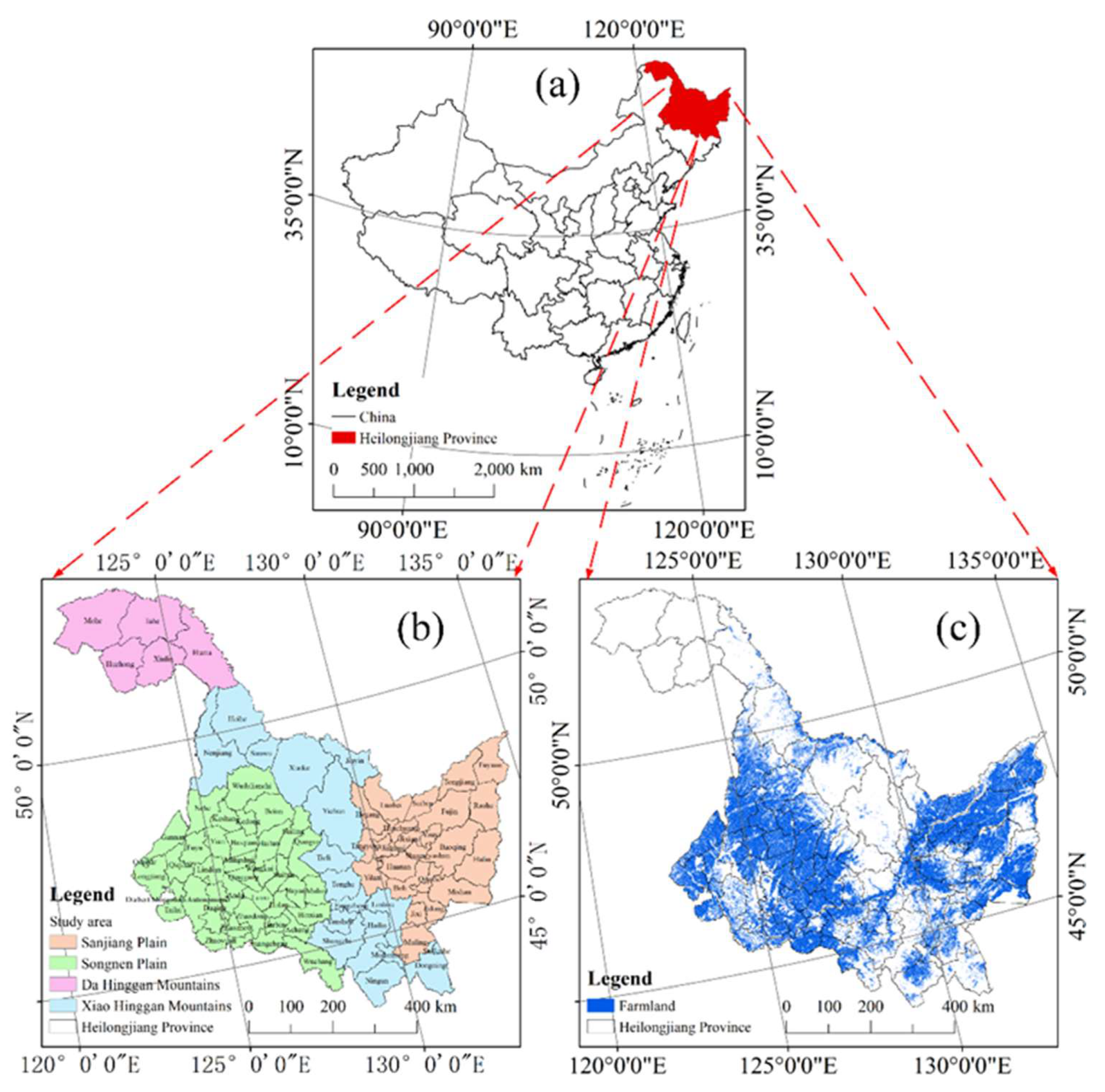
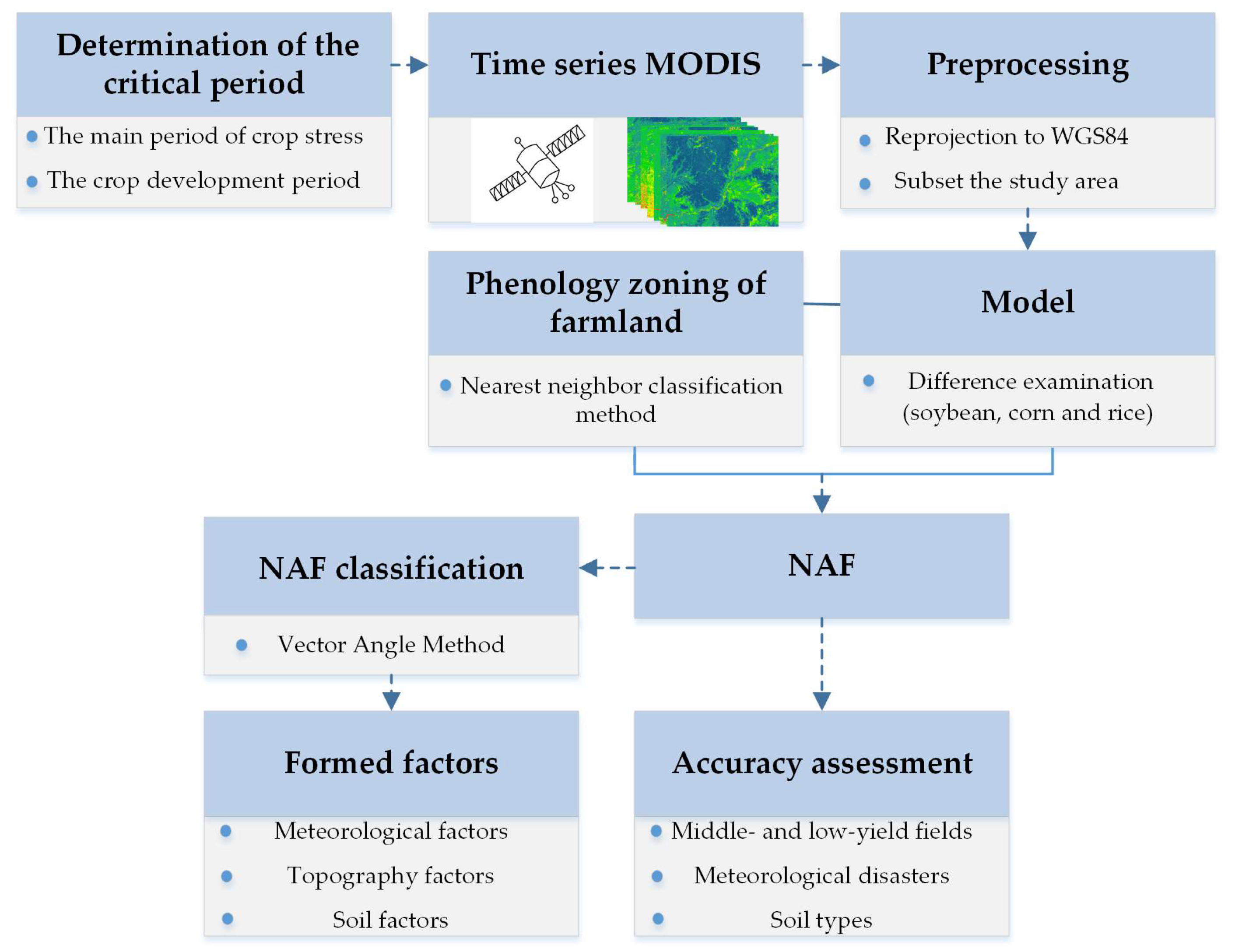
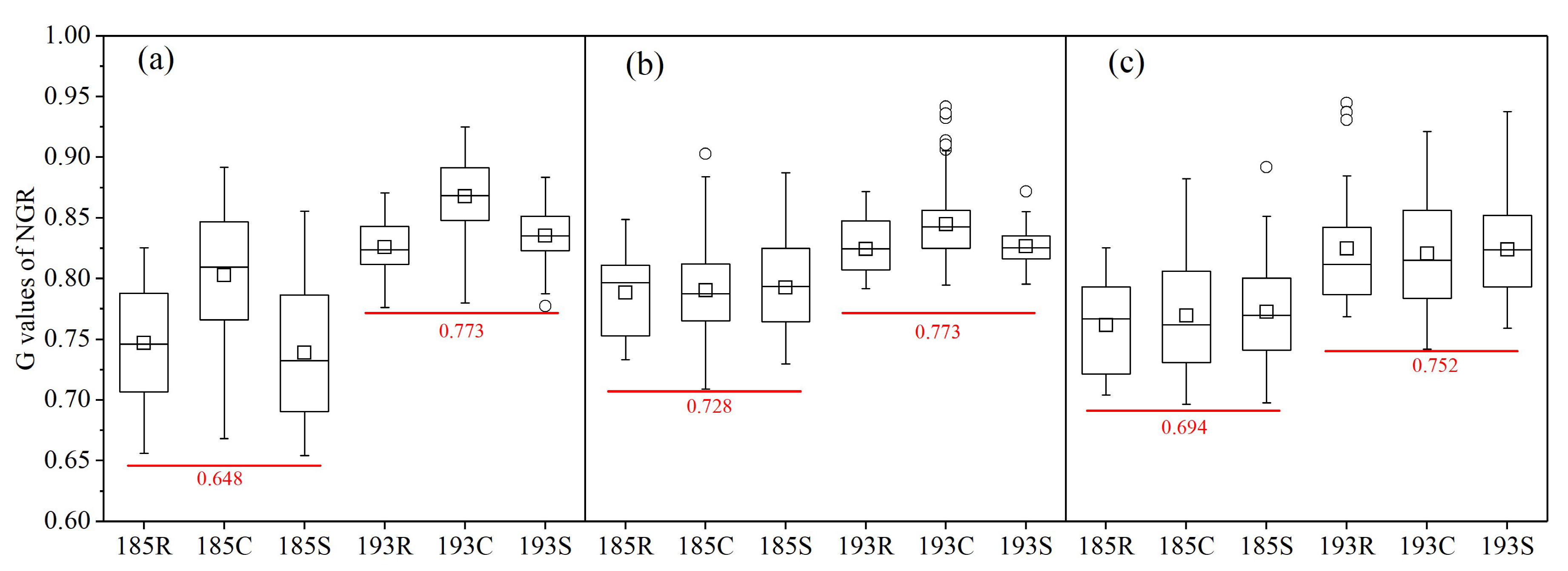

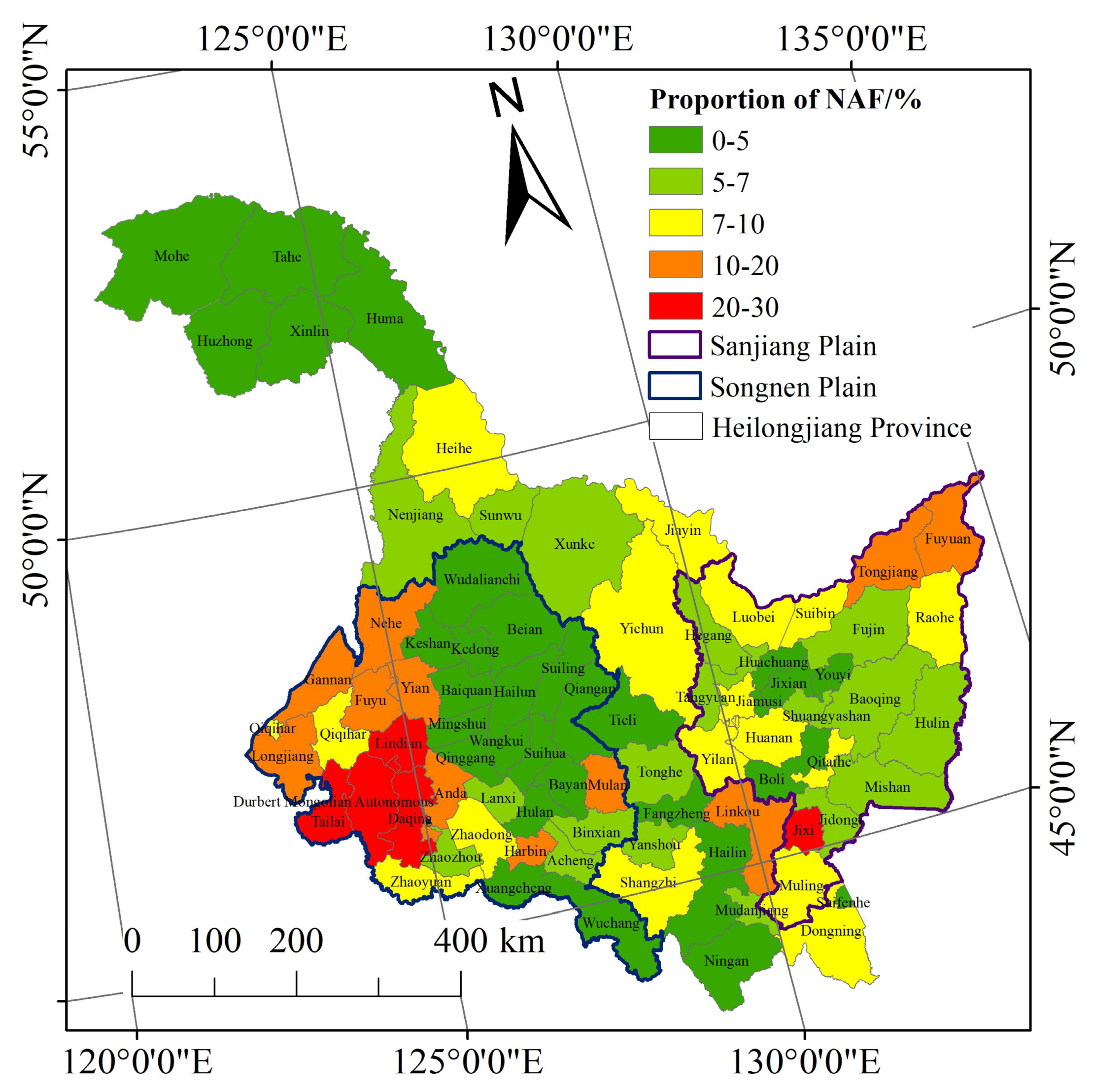
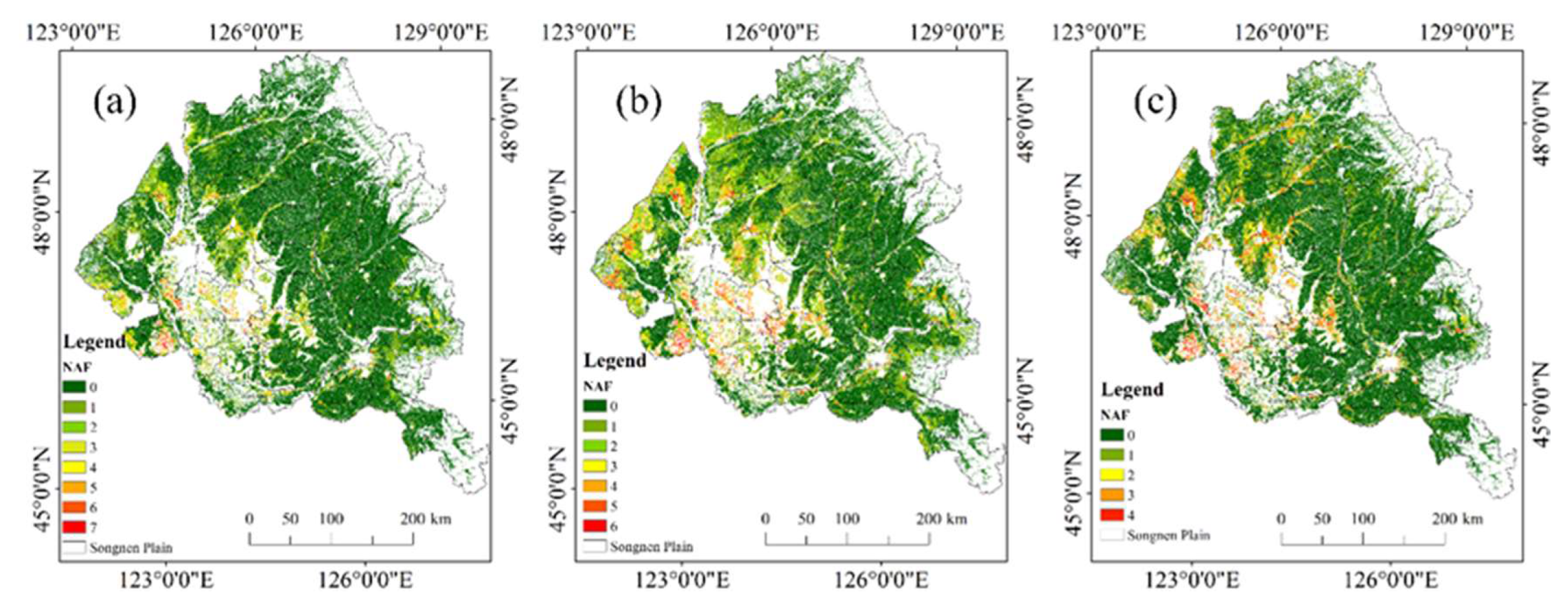
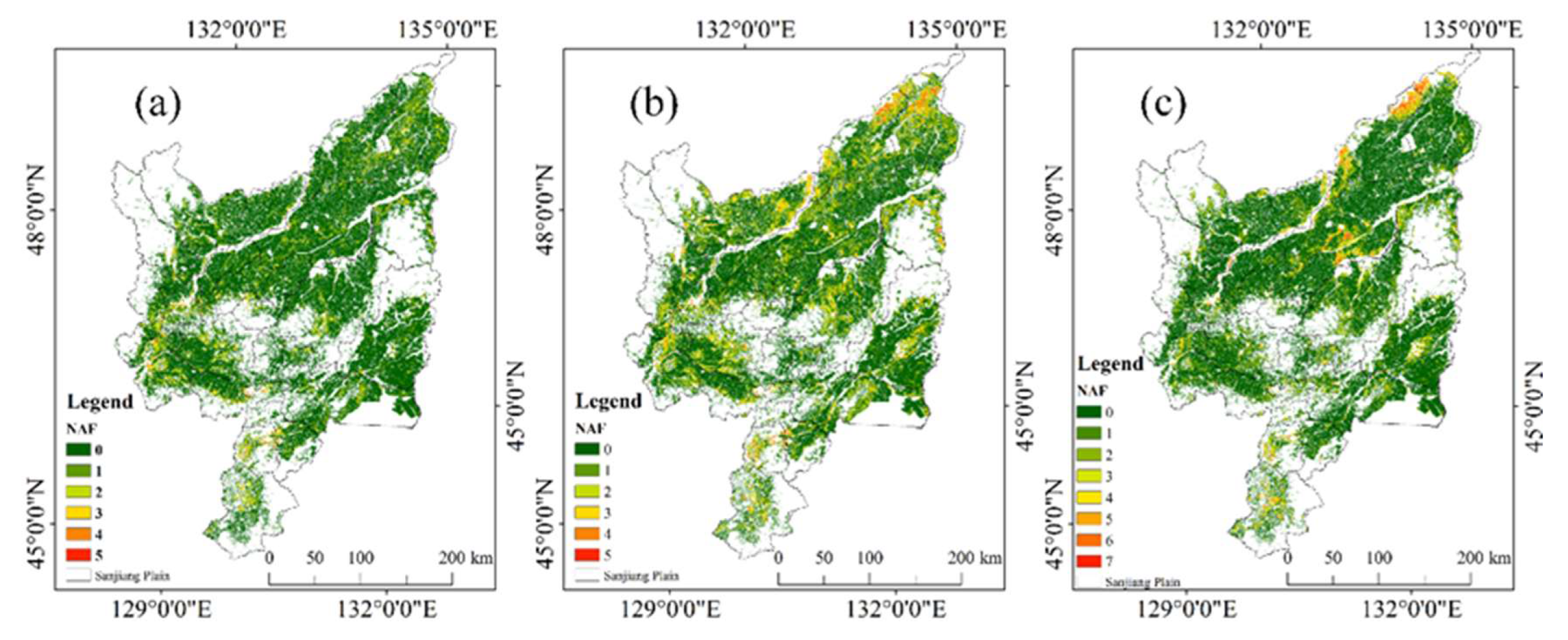



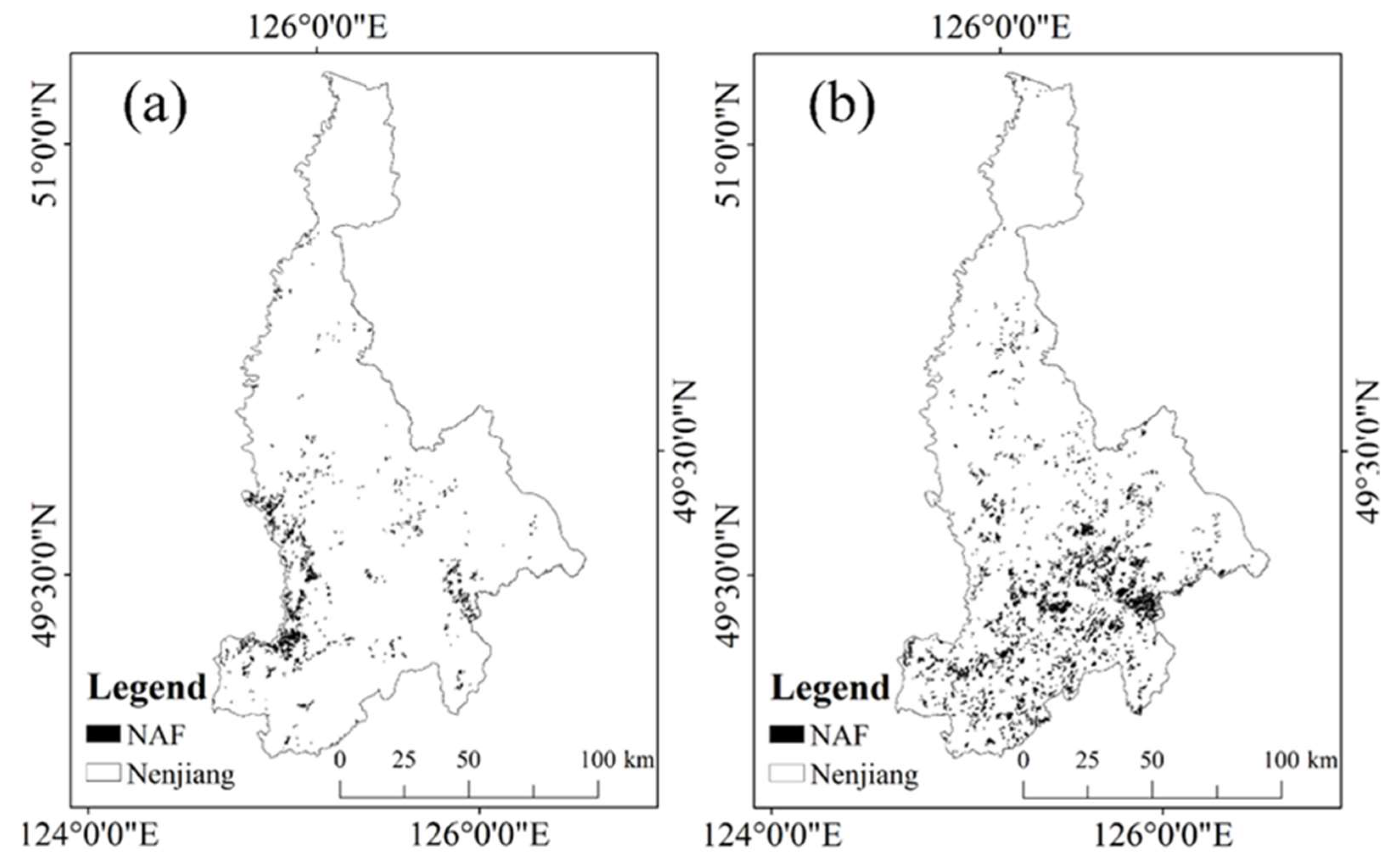
| Month | 4 | 5 | 6 | 7 | 8 | 9 | ||||||||||||||
|---|---|---|---|---|---|---|---|---|---|---|---|---|---|---|---|---|---|---|---|---|
| Ten Days | 1 | 2 | 3 | 1 | 2 | 3 | 1 | 2 | 3 | 1 | 2 | 3 | 1 | 2 | 3 | 1 | 2 | 3 | ||
| Huma | Wheat | SW | SD | HD | MT | |||||||||||||||
| Soybean | SW | SD | FL | PD | MT | |||||||||||||||
| Hailun | Corn | SW | SD | JT | TS | HD | ML | MT | ||||||||||||
| Potato | SW | SD | FL | MT | ||||||||||||||||
| Hulin | Rice | SW | TP | TL | HD | MT | ||||||||||||||
| Sanjiang Plain | Songnen Plain | NW | SE | ||||||
|---|---|---|---|---|---|---|---|---|---|
| Yilan | Baoqing | Fuyuan | Gannan | Longjiang | Lanxi | Nenjiang | Heihe | Ning’an | |
| P | −0.82 ** | −0.53 * | −0.38 | −0.38 | −0.57 * | −0.10 | 0.19 | 0.19 | −0.14 |
| T | 0.43 | 0.30 | 0.06 | 0.07 | 0.55 * | 0.50 * | −0.45 | 0.49 * | −0.06 |
© 2020 by the authors. Licensee MDPI, Basel, Switzerland. This article is an open access article distributed under the terms and conditions of the Creative Commons Attribution (CC BY) license (http://creativecommons.org/licenses/by/4.0/).
Share and Cite
Yu, S.; Zhang, X.; Zhang, X.; Liu, H.; Qi, J.; Sun, Y. Detecting and Assessing Nondominant Farmland Area with Long-Term MODIS Time Series Images. Remote Sens. 2020, 12, 2441. https://doi.org/10.3390/rs12152441
Yu S, Zhang X, Zhang X, Liu H, Qi J, Sun Y. Detecting and Assessing Nondominant Farmland Area with Long-Term MODIS Time Series Images. Remote Sensing. 2020; 12(15):2441. https://doi.org/10.3390/rs12152441
Chicago/Turabian StyleYu, Shengnan, Xiaokang Zhang, Xinle Zhang, Huanjun Liu, Jiaguo Qi, and Yankun Sun. 2020. "Detecting and Assessing Nondominant Farmland Area with Long-Term MODIS Time Series Images" Remote Sensing 12, no. 15: 2441. https://doi.org/10.3390/rs12152441
APA StyleYu, S., Zhang, X., Zhang, X., Liu, H., Qi, J., & Sun, Y. (2020). Detecting and Assessing Nondominant Farmland Area with Long-Term MODIS Time Series Images. Remote Sensing, 12(15), 2441. https://doi.org/10.3390/rs12152441







